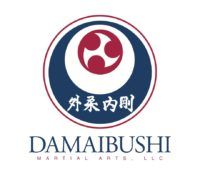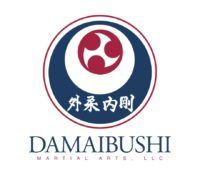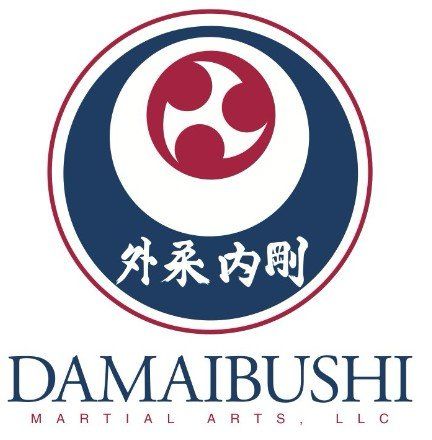Explanation of Damaibushi Martial Arts Logo & LLC
“Quiet Knight”

Definition
The term “Damaibushi” is Okinawan in origin, and, as with so many things from the Okinawan/Japanese language(s), there is really no literal translation that fits neatly. The closest translation is “Quiet Warrior”, or more appropriately, “Quiet Knight”, since the term “warrior” in this context denotes more than just someone who fights, but one who also lives by a strong moral and ethical code, especially when it comes to using martial skills against another human being.
Etymology:
A warrior, or “bushi” is someone who lives by the code of “Bushido”. Many extensive books and articles are available on Bushido and anyone reading this is encouraged to seek them out if he/she is interested. A very simplified and short version is that it deals w/honor, integrity, compassion, strength, “hard and soft”, how to treat people, honesty, sacrifice, and doing what is right even when (or especially when) doing so may be the hardest thing. The people who introduced and elaborated to me on the term and what it means were Okinawan martial artists, Bushi themselves who come from numerous generations of Bushi or Okinawan Samurai. They were/are the late Kuda Yuichi No Tanmei, and his son, Kuda Tomosada. Kuda Yuichi No Tanmei stated it fairly simply in broken English, saying it is “someone not too much talk, just do”, “somebody no bullshit”. Kuda Tomosada elaborated on this a bit more saying that it is somebody who if they know 10 things, may only show 2 of those things (to outsiders) and keep the rest to himself. They both stated that it is the opposite of “Kuchibushi”, which is basically a “Talking Warrior”, or someone who talks too much, does too little, is boastful and egotistical, or a showoff.
History
In 1997, after having spent some time w/Kuda Yuichi No Tanmei doing seminars, I had to leave him for a few days for work obligations before rejoining him later. As I was driving off, he told a very close friend and associate of mine (and senior student of his) that “I think Fred is Damaibushi”. Because of the extraordinarily profound effect Kuda No Tanmei had on me, and the high regard I held him in, when I heard that he had said this it meant a great deal to me. Ten years later, when I needed to form an LLC under which I did my Martial Arts teaching, the Company needed a name. I chose Damaibushi Martial Arts as the name. When I told Kuda Tomosada about the name and about how his Father had said he thought I was a Damaibushi, he said that after he had gotten to know me, coupled w/what his Father had told him about me, he thought that the name described me perfectly and that it was a good name for the Company.
Design
The Logo for Damaibushi Martial Arts LLC is modeled after an early idea for the flag for Okinawa, w/some significant modifications and additions. Since what I teach is either directly from or heavily influenced by Okinawan Karate, I felt this to be very appropriate. Since I am also a proud American, I thought that the red, white, and blue color scheme was something I wanted to use Okinawa is an island, so of course is surrounded by water. That can be seen within this logo. The design w/in the small, red circle is known as the three tears, and comes from an old Okinawan legend. As w/most legends, there are many versions, and how much truth there is to any of them is certainly open for debate. The version that had the most effect on me is that there was an Okinawan who had allegedly committed some infraction or slight against the Japanese overlords of the Okinawa. (Okinawa, once an independent kingdom, had been subjugated by the Japanese). This Okinawan man was sentenced to be thrown into a pot of boiling oil and was being held on each side by a Japanese Samurai. Instead of pleading or begging for his life, when the time came, the Okinawan grabbed both of the Japanese Samurai and jumped into the pot of boiling oil, pulling both Samurai Guards w/him. The insignia w/in the red circle represents the three of them swirling around in the pot of oil. I found this to be a most interesting story, and would hope that when my time comes, no matter what the circumstances, I can go out w/such honor and courage.

ABOUT
The Kanji (the calligraphic writing) w/in the blue circle says “Outside soft, inside hard”. According to Kuda Tomosada, this means that one is outwardly kind, forgiving, and understanding towards others and accepting of their efforts, when it comes to themselves, inside they are driven, demanding, always driving for perfection/improvement, and do not accept mediocrity. They are never satisfied w/themselves and their own efforts, but are always driven to be better. Kuda Tomosada said that he felt this described me perfectly, and that my including this in the logo was a very good idea.
“Outside soft, inside hard” can also mean that on the outside, something (or someone) can appear harmless or not strong, but below the innocent – appearing surface, is strength. A person can be this way, techniques can appear this way. It is also a way of not showing what is really beneath the surface, but having people believe a person or technique is something less than what he/she/it really is. It can cause others to believe you are not a threat, so they will either pass you by, or if they choose to attack, they will be careless because they do perceive any strength or danger.
